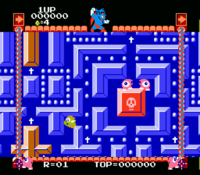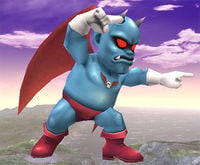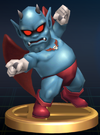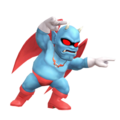Devil: Difference between revisions
m (→References: SmashPedia link.) |
N. Onymous (talk | contribs) |
||
| Line 61: | Line 61: | ||
The Devil returns as an Assist Trophy. [[Training Mode]] describes his Assist Trophy with the following: ''Moves the stage in whichever direction he points. Can't be KO'd.'' | The Devil returns as an Assist Trophy. [[Training Mode]] describes his Assist Trophy with the following: ''Moves the stage in whichever direction he points. Can't be KO'd.'' | ||
Devil will never spawn in [[Custom Smash]] if the camera is set to "fixed". Spawning him in Training Mode under this setting will override the fixed camera, and will not return it to normal again when he despawns. | |||
====Available Stages==== | |||
{|class="wikitable sortable mw-collapsible" | |||
!|Stage | |||
!|Available? | |||
|- | |||
|[[Battlefield (SSBU)|Battlefield]] | |||
|{{y}} | |||
|- | |||
|[[Big Battlefield (SSBU)|Big Battlefield]] | |||
|{{y}} | |||
|- | |||
|[[Small Battlefield]] | |||
|{{y}} | |||
|- | |||
|[[Final Destination (SSBU)|Final Destination]] | |||
|{{y}} | |||
|- | |||
|[[Peach's Castle]] | |||
|{{n}} | |||
|- | |||
|[[Kongo Jungle]] | |||
|{{y}} | |||
|- | |||
|[[Hyrule Castle]] | |||
|{{n}} | |||
|- | |||
|[[Super Happy Tree]] | |||
|{{y}} | |||
|- | |||
|[[Dream Land]] | |||
|{{n}} | |||
|- | |||
|[[Saffron City]] | |||
|{{y}} | |||
|- | |||
|[[Mushroom Kingdom (SSB)|Mushroom Kingdom]] | |||
|{{y}} | |||
|- | |||
|[[Princess Peach's Castle]] | |||
|{{y}} | |||
|- | |||
|[[Rainbow Cruise]] | |||
|{{n}} | |||
|- | |||
|[[Kongo Falls]] | |||
|{{y}} | |||
|- | |||
|[[Jungle Japes]] | |||
|{{n}} | |||
|- | |||
|[[Great Bay]] | |||
|{{y}} | |||
|- | |||
|[[Temple]] | |||
|{{n}} | |||
|- | |||
|[[Brinstar]] | |||
|{{n}} | |||
|- | |||
|[[Yoshi's Island (SSBM)|Yoshi's Island (Melee)]] | |||
|{{n}} | |||
|- | |||
|[[Yoshi's Story]] | |||
|{{y}} | |||
|- | |||
|[[Fountain of Dreams]] | |||
|{{y}} | |||
|- | |||
|[[Green Greens]] | |||
|{{y}} | |||
|- | |||
|[[Corneria]] | |||
|{{y}} | |||
|- | |||
|[[Venom]] | |||
|{{y}} | |||
|- | |||
|[[Pokémon Stadium]] | |||
|{{y}} | |||
|- | |||
|[[Onett]] | |||
|{{n}} | |||
|- | |||
|[[Mushroom Kingdom II]] | |||
|{{y}} | |||
|- | |||
|[[Brinstar Depths]] | |||
|{{n}} | |||
|- | |||
|[[Big Blue]] | |||
|{{n}} | |||
|- | |||
|[[Fourside]] | |||
|{{y}} | |||
|- | |||
|[[Delfino Plaza]] | |||
|{{n}} | |||
|- | |||
|[[Mushroomy Kingdom]] | |||
|{{n}} | |||
|- | |||
|[[Figure-8 Circuit]] | |||
|{{n}} | |||
|- | |||
|[[WarioWare, Inc.]] | |||
|{{n}} | |||
|- | |||
|[[Bridge of Eldin]] | |||
|{{n}} | |||
|- | |||
|[[Norfair]] | |||
|{{n}} | |||
|- | |||
|[[Frigate Orpheon]] | |||
|{{y}} | |||
|- | |||
|[[Yoshi's Island (SSBB)|Yoshi's Island]] | |||
|{{y}} | |||
|- | |||
|[[Halberd]] | |||
|{{n}} | |||
|- | |||
|[[Lylat Cruise]] | |||
|{{y}} | |||
|- | |||
|[[Pokémon Stadium 2]] | |||
|{{y}} | |||
|- | |||
|[[Port Town Aero Dive]] | |||
|{{n}} | |||
|- | |||
|[[Castle Siege]] | |||
|{{n}} | |||
|- | |||
|[[Distant Planet]] | |||
|{{n}} | |||
|- | |||
|[[Smashville]] | |||
|{{y}} | |||
|- | |||
|[[New Pork City]] | |||
|{{y}} | |||
|- | |||
|[[Summit]] | |||
|{{n}} | |||
|- | |||
|[[Skyworld]] | |||
|{{y}} | |||
|- | |||
|[[Shadow Moses Island]] | |||
|{{n}} | |||
|- | |||
|[[Luigi's Mansion]] | |||
|{{n}} | |||
|- | |||
|[[Pirate Ship]] | |||
|{{n}} | |||
|- | |||
|[[Spear Pillar]] | |||
|{{n}} | |||
|- | |||
|[[75m]] | |||
|{{n}} | |||
|- | |||
|[[Mario Bros.]] | |||
|{{n}} | |||
|- | |||
|[[Hanenbow]] | |||
|{{n}} | |||
|- | |||
|[[Green Hill Zone]] | |||
|{{y}} | |||
|- | |||
|[[3D Land]] | |||
|{{n}} | |||
|- | |||
|[[Golden Plains]] | |||
|{{n}} | |||
|- | |||
|[[Paper Mario]] | |||
|{{n}} | |||
|- | |||
|[[Gerudo Valley]] | |||
|{{n}} | |||
|- | |||
|[[Spirit Train]] | |||
|{{n}} | |||
|- | |||
|[[Dream Land GB]] | |||
|{{n}} | |||
|- | |||
|[[Unova Pokémon League]] | |||
|{{n}} | |||
|- | |||
|[[Prism Tower]] | |||
|{{n}} | |||
|- | |||
|[[Mute City SNES]] | |||
|{{n}} | |||
|- | |||
|[[Magicant]] | |||
|{{y}} | |||
|- | |||
|[[Arena Ferox]] | |||
|{{y}} | |||
|- | |||
|[[Reset Bomb Forest]] | |||
|{{n}} | |||
|- | |||
|[[Tortimer Island]] | |||
|{{n}} | |||
|- | |||
|[[Balloon Fight]] | |||
|{{n}} | |||
|- | |||
|[[Living Room]] | |||
|{{n}} | |||
|- | |||
|[[Find Mii]] | |||
|{{y}} | |||
|- | |||
|[[Tomodachi Life]] | |||
|{{n}} | |||
|- | |||
|[[PictoChat 2]] | |||
|{{y}} | |||
|- | |||
|[[Mushroom Kingdom U]] | |||
|{{y}} | |||
|- | |||
|[[Mario Galaxy]] | |||
|{{n}} | |||
|- | |||
|[[Mario Circuit (SSB4)|Mario Circit]] | |||
|{{n}} | |||
|- | |||
|[[Skyloft]] | |||
|{{n}} | |||
|- | |||
|[[The Great Cave Offensive]] | |||
|{{n}} | |||
|- | |||
|[[Kalos Pokémon League]] | |||
|{{y}} | |||
|- | |||
|[[Coliseum]] | |||
|{{n}} | |||
|- | |||
|[[Flat Zone X]] | |||
|{{n}} | |||
|- | |||
|[[Palutena's Temple]] | |||
|{{n}} | |||
|- | |||
|[[Gamer]] | |||
|{{n}} | |||
|- | |||
|[[Garden of Hope]] | |||
|{{y}} | |||
|- | |||
|[[Town and City]] | |||
|{{y}} | |||
|- | |||
|[[Wii Fit Studio]] | |||
|{{n}} | |||
|- | |||
|[[Boxing Ring]] | |||
|{{n}} | |||
|- | |||
|[[Gaur Plain]] | |||
|{{n}} | |||
|- | |||
|[[Duck Hunt (stage)|Duck Hunt]] | |||
|{{y}} | |||
|- | |||
|[[Wrecking Crew]] | |||
|{{n}} | |||
|- | |||
|[[Pilotwings]] | |||
|{{y}} | |||
|- | |||
|[[Wuhu Island]] | |||
|{{n}} | |||
|- | |||
|[[Windy Hill Zone]] | |||
|{{y}} | |||
|- | |||
|[[Wily Castle]] | |||
|{{y}} | |||
|- | |||
|[[Pac-Land]] | |||
|{{n}} | |||
|- | |||
|[[Super Mario Maker]] | |||
|{{n}} | |||
|- | |||
|[[Suzaku Castle]] | |||
|{{n}} | |||
|- | |||
|[[Midgar]] | |||
|{{n}} | |||
|- | |||
|[[Umbra Clock Tower]] | |||
|{{y}} | |||
|- | |||
|[[New Donk City Hall]] | |||
|{{n}} | |||
|- | |||
|[[Great Plateau Tower]] | |||
|{{y}} | |||
|- | |||
|[[Moray Towers]] | |||
|{{n}} | |||
|- | |||
|[[Dracula's Castle]] | |||
|{{y}} | |||
|- | |||
|[[Mementos]] | |||
|{{n}} | |||
|- | |||
|[[Yggdrasil's Altar]] | |||
|{{y}} | |||
|- | |||
|[[Spiral Mountain]] | |||
|{{y}} | |||
|- | |||
|[[King of Fighters Stadium]] | |||
|{{n}} | |||
|- | |||
|[[Garreg Mach Monastery]] | |||
|{{n}} | |||
|- | |||
|[[Spring Stadium]] | |||
|{{n}} | |||
|- | |||
|[[Minecraft World]] | |||
|{{y}} | |||
|- | |||
|[[Northern Cave]] | |||
|{{y}} | |||
|- | |||
|[[Cloud Sea of Alrest]] | |||
|{{n}} | |||
|} | |||
===Spirit=== | ===Spirit=== | ||
Revision as of 18:48, May 12, 2021
| Devil | |
|---|---|
 The in-game sprite of Devil from Devil World. | |
| Universe | Devil World |
| Debut | Devil World (1984) |
| Smash Bros. appearances | Brawl SSB4 Ultimate |
| Most recent non-Smash appearance | Art Style: PiCTOBiTS (cameo, 2009) |
| Console/platform of origin | Nintendo Entertainment System |
| Species | Demon |
| Gender | Male |
| Place of origin | Devil World |
| Created by | Shigeru Miyamoto |
The Devil (デビル, Devil) (called Demon on the British version of the Smash Bros. DOJO!!) is the villain in the NES game Devil World, developed by Shigeru Miyamoto, which was released for the Japanese Famicom and PAL NES systems only.
Origin
The Devil debuts as the villain and main hazard in Devil World. He is based on the Devil, who appears in several religions as the personification of evil. In the game, he tries to thwart the efforts of the heroic dragon Tamagon to destroy him and seal Devil World away for eternity. He appears in every non-bonus level at the top of the screen, pointing in various directions in order to make the walls of the current game area shift around the level, thus limiting the player's movement to a small window of the full maze. When a stage is cleared, the Devil recoils, turns into a bat and flies away.
In Super Smash Bros. Melee
The Devil was mentioned in the description of the Tamagon trophy as "a large, winged demon". This trophy was only available legitimately in the Japanese version of Melee.
In Super Smash Bros. Brawl
As an assist trophy
When released, the Devil appears as a bat, flies to the top of the screen and turns into his humanoid form. He then starts pointing in various directions, accompanied by an 8-bit sound from his source game: this causes the screen to scroll in the opposite direction, effectively altering the offscreen boundaries of the stage. The effect is great enough that it can leave just a small section of a stage, e.g. Battlefield, remaining. When playing in Pirate Ship, it is also possible for the entire stage to be moved offscreen. This also allows for more camera control freedom when the game is paused. After a short while, the Devil disappears in a puff of smoke and the screen turns back to normal.
Trophy
- Devil
- A devil who wields serious power in Devil World. In the game, the devil floats above the maze and commands by pointing. When it gives orders, its cyclopean minions turn cranks that scroll the maze in different directions. When Tamagon, your character in the game, places all the stage's books into a hole, the devil turns into a bat and flies away. It's quite striking, no?
: Devil World
The NTSC version of Brawl lists the game as 'Japan Only' in error. The PAL version corrects this.
In Super Smash Bros. 4
As an Assist Trophy
The Devil returns from Brawl, his function completely unchanged, allowing the player to see beyond the camera boundaries of many new stages.
However, one slight change was made to Devil in Smash 4. Certain moves such as Flip Jump can now connect with Devil[1], proving that he has a hurtbox, despite being immune to the effects of attacks.
Trophies
The Devil trophy appears in both versions. In Super Smash Bros. for Wii U it is part of the NES Trophy Box.
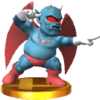
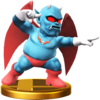
- Devil
: A devil who holds absolute authority in Devil World. When he appears, he'll fly into the sky as a bat and then transform into his devil form. He'll then begin to point frantically in different directions, scrolling the stage where he points. You're...not really helping things, buddy.
: A devil who appears to hold absolute power in Devil World. In bat form, it flies to its perch, then turns back into a devil and begins waving frantic orders to make the screen scroll all different ways. Considering that it's an assist trophy, it's not doing much in the way of assisting.
: Devil World (JP & EU)
In Super Smash Bros. Ultimate
As an Assist Trophy
The Devil returns as an Assist Trophy. Training Mode describes his Assist Trophy with the following: Moves the stage in whichever direction he points. Can't be KO'd.
Devil will never spawn in Custom Smash if the camera is set to "fixed". Spawning him in Training Mode under this setting will override the fixed camera, and will not return it to normal again when he despawns.
Available Stages
Spirit
| No. | Image | Name | Type | Class | Cost | Ability | Series |
|---|---|---|---|---|---|---|---|
| 1,119 | Devil | ★★ | 2 | Screen-Flip Immunity | Devil World |
Gallery
Devil in Super Smash Bros. for Nintendo 3DS.
Devil's bat form in Super Smash Bros. for Nintendo 3DS.
Names in other languages
Trivia
- With his debut in October 1984, Devil is the oldest Assist Trophy in Super Smash Bros. Brawl.
- Devil is the only Assist Trophy from a non-playable universe who is a villain in his home series.
- Rathalos is an enemy, but not a villain.
- If the Devil is summoned during fixed camera mode, the stage won't be moved.
- In for Wii U, this also allows Devil to move the stage twice in the same direction when playing Training mode (if the player switches between Fixed and Normal camera at the right timing while Devil is currently on stage). It is unknown whether this counts as a glitch or not. However, the 3DS version disables the camera-toggle in Training mode when Devil is summoned, and in Ultimate, the camera turns normal when summoning Devil during fixed-camera in Training mode.[1]
- Devil cannot be summoned in 63 (67 including DLC) stages in Super Smash Bros. Ultimate, making him the most limited Assist Trophy in Ultimate.
References
